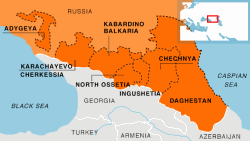For years, activists in Vladikavkaz, capital of the Republic of North Ossetia-Alania, have staged sporadic pickets to demand the closure of the Elektrotsink metallurgical plant, a major source of environmental pollution.
Until recently, both the republican and the federal authorities have ignored those demands and consistently downplayed the alleged threat posed to public health by mass-scale toxic emissions from the plant, which ecological activists say vastly exceed the permitted maximum.
Visiting the republic this week, however, federal envoy to the North Caucasus Federal District Sergei Melikov announced that the authorities have reached agreement with Elektrotsink's owners, the Urals Mining-Metallurgical Group, on ending the production of zinc (of which Elektrotsink is reportedly the second-largest producer in the Russian Federation) this summer in light of the huge amount of toxic waste that has accumulated over the years. The production of sulfuric acid is to be totally modernized by the end of 2017.
That statement represents a clear volte face. Less than 18 months ago, Melikov claimed that regular monitoring of the levels of lead and zinc at schools and kindergartens in Vladikavkaz had failed to identify "any negative factors affecting [people's] health." He dismissed the ongoing protests calling for the closure of the plant as "a totally destructive policy."
Two possible factors may have influenced the federal authorities' belated decision to take action against Elektrotsink. The first is the changes in the North Ossetian leadership following the expiry last June of longtime republic head Taymuraz Mamsurov's second term in office. Mamsurov was on record as saying that it was more harmful to inhale the fumes from a barbecue than the toxic emissions from Elektrotsink.
Vyacheslav Bitarov, who served as prime minister under Mamsurov's successor, Tamerlan Aguzarov, and whom Russian President Vladimir Putin named acting republic head in late February following Aguzarov's untimely death, announced in late December that Aguzarov was insisting the plant be relocated beyond North Ossetia's borders. Experts calculated that doing so would take five years.
In early April, Bitarov again said he would raise with Elektrotsink's owners the possibility of relocating the plant, and also of it acquiring the necessary equipment to monitor constantly the level of toxic emissions.
It is conceivable that the Russian leadership recognized the potential benefits, in the run-up to the State Duma elections in September, of a concession to North Ossetia's electorate, especially one that would not entail spending from the federal budget. But there is also a second reason why Moscow should have decided to take a closer look at Elektrotsink's operations: Melikov disclosed that the taxes the plant paid did not find their way into the republic's budget. For that reason it will be required to pay at least 300 million rubles ($4.58 million) this year. (In 2014, the plant paid 142 million rubles into the municipal and republican budgets.)
At the same time, although Melikov did not say so outright, it seems unlikely that the federal authorities would back Bitarov's demand to relocate all Elektrotsink's operations outside North Ossetia. Melikov stressed the need to find a balance between two priorities: reducing the negative ecological impact of the plant's operations, while minimizing the number of staffers made redundant. He calculated that the termination of lead production would result in the loss of more than 200 jobs, of a total workforce of some 2,000. The most qualified personnel would be offered the chance of transferring to the Urals Mining-Metallurgical Group's main plant in the Urals, according to the enterprise's deputy general director, Yevgeny Bragin, but it is not clear how many would be prepared to relocate there.
Even the loss of 200 jobs from Elektrotsink would exacerbate North Ossetia's chronic unemployment problem. Of the republic's estimated total workforce of 340,000 people, 8.6 percent were unemployed as of July 2015. A further 300 people have already lost their jobs this year.





